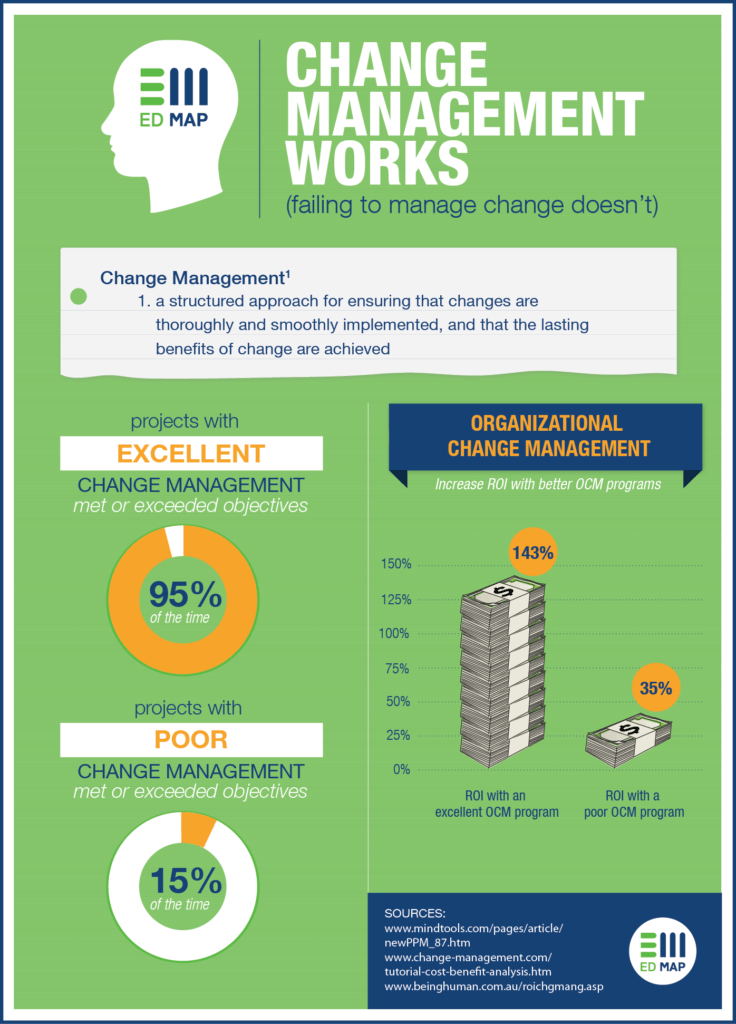It’s a bit cliche, but true nonetheless: ‘Change is the only constant’. If you’re looking to run a successful business in a dynamic, consumer-driven, and globally competitive market, this zen-like motivational poster quote should be your mantra. Today, change management in your organization is not just your ticket to success. it’s also the way to ensure a competitive edge that will help you survive.
Each day, you are looking for new initiatives and projects to launch in order to improve performance (employees, customers, and the company), increase profits, and boost your competitive advantage. How you plan to make this change is up to you – maybe it is through new technology to enable a better mobile workforce, redesigning a process to ensure 100% regulatory compliance, or chasing an enterprise-wide transformation around your customer experience. In any case, you’ll never achieve that change without people.

There’s a broad selection of approaches and change management models available. Whichever you decide on, we’ve collected 10 proven activities to help you implement them effectively. But before we discuss the “how”, let us first define what change management actually is.
Q: What Is Change Management?
A: Change management is the application of processes, methods, body of knowledge, skills, and experience to bring about the people side of change, thus optimizing the benefits of an initiative. – Daniel Lock
Change is the transition from one state to another. We all experience change in all aspects of our lives, whether we want to or not. It can be motivated by internal forces, or external demands and constraints. It can be expected and planned, or a complete surprise. Some changes can be minor, while some turn your world upside-down. However, most changes you face in your personal life don’t require the involvement of more than a handful of people. In business, it doesn’t work quite like that.
When it comes to business, undertaking an organizational change means giving structure to the process of transition from the “now” to the desired future outcome. This transition cannot happen without the employees affected by the process and its results taking an active part in it. To make a business initiative a success, you need to get your employees on board and involved in its adoption. Change management aims to do just that.
Why You Need To Manage Change In Your Business
People are different. While some welcome change and embrace it, others resist it and some might even be upset by it.
Like Janice from Accounting. Always rolling her eyes even at the smallest of changes that somehow alter her daily routine. Because she just doesn’t give a &#%.
Change management is necessary because it provides the process, tools, and approaches to bring about the individual transitions that make up the overall organizational change.
IBM’s survey found that change management executives listed “people factors” as the biggest barriers to success: Changing mindsets and attitudes – 58%, Corporate Culture – 49%, Lack of senior management support – 32%. These findings could easily explain why 48% of strategic initiatives fail.
Without successful change management, your organization will fail to respond to external drivers for change. Strategic organizational initiatives, intended to grow your business in an increasingly competitive environment, will fail in nearly half the cases. But don’t lose hope – there’s a lot you can do to successfully manage organizational change.
Top Change Management Activities
Normally, we seek out change management activities when preparing to deal with an oncoming change, or looking to successfully execute an organizational transition of some sort. What we sometimes neglect to do is consider long-term change management activities that provide tools and processes to support more than a single initiative (either consecutively or concurrently).
Some change management strategies, applied and executed with one initiative, can then be used when promoting another. We call this “recycling” and we are big supporters of this eco-conscious approach. In the list of strategies below, We made sure to include some tips on recycling strategies and tools. As you will see, some strategies that seem very initiative-specific can be beneficial beyond the scope of a specific change initiative.
Start with Identification
The employees affected by the initiative are often those crucial to its success. So the first thing you must do is identify and categorize the three different employee types, and create a different approach and communication tactics for each.
Spot The Rebel Stronghold (the rebel)
Rebellions are best nipped in the bud, just ask Darth Vader. Identify your most resistant employees then figure out what it is holding them back. Some negative attitudes and “alternative facts” can spread like a virus in an organization, creating massive hurdles. By identifying these common causes for resistance, you can then try to discern them, or alternatively, adjust the transition so that it accommodates the needs and demands of the resistant employees.
Embrace Your Change Ambassadors (the recruit)
Early adopters are quite easy to identify. They’re usually the ones with the latest gadgets on their desks and geeky t-shirts as their casual work attire. These are the best ambassadors of change for you to recruit and embrace as leaders, sources of valuable insights, and spokesmen on your behalf in their teams and department. They might just have better success at reaching Janice to make her give a &^@# than you do.
Those Who Need a Nudge (the bystander)
The third group of employees is the passive ones. The neutral bystander, so to speak. They are likely to go with the flow IF you can generate enough change momentum after completing steps 1 and 2. The bystander might simply not understand it or know enough about its repercussions on their day-to-day work functions.
Or they could just not care, like Janice from accounting. Identifying the reasons for the lack of participation or interest can help you start planning the optimal tactics to get these employees to (hopefully) become change ambassadors.
In the long run, identifying and categorizing employees as an anti, pro, or indifferent to organizational change can help you approach future initiatives (or present ones) knowing what to expect. In addition, learning more about your employees and their general attitudes toward change can offer invaluable insights that go far beyond a specific transition process.
Engage
Overall, engagement is key in promoting organizational change, but it can’t happen only as part of a transition. Engaging your employees is something you should be doing constantly and consistently for a multitude of reasons. Mainly, because these change management tools can serve you in the future in a multitude of ways.
Get Together
Town-hall meetings, physical or virtual, are a great way to get employees involved and communicating with each other and senior management in a comfortable setting. Though somewhat chaotic when large groups of employees are involved, these meetings can be a helpful tool in identifying causes and leaders of the resistance and starting a conversation.
However, why not implement change with a game-changing tool. Is your mind blown yet?! Instead of bringing everyone into the office for a town hall meeting, change the way you communicate using an employee app. With an employee app, you can engage your workforce wherever they are, at any time, in a way they like and are used to communicating. Companies who have used Connecteam for this process have seen engagement go up by as much as 70%, which made implementing change a lot easier.
Progress Updates
Keeping everyone involved in a complex process can be excruciatingly hard. Luckily, there’s no shortage of tools to let you create a newsletter to inform employees on the progress of a transition that affects them directly. But, again, let’s make the process of introducing change more innovative and exciting in its own right.
Newsletters are great to send information in one direction. The manager can send everyone in the company a newsletter to keep them up to date but the process ends there. There’s no real two-way communication going on.
This is where you can use Connecteam to send Updates via the mobile app. Updates work like Facebook posts and allow everyone to engage, like, and comment on updates. The manager can also receive an engagement report and take action on their employees’ comments.

Sign up for Connecteam’s employee communication app for free today!
Welcome Employee Feedback
An employee feedback program is an easy way to receive feedback from employees throughout the change process. This feedback can come in the form of questionnaires, quizzes, and individual interviews with employees from all the categories you identified earlier, which, you guessed it, you can all do through Connecteam.
In the long run, all these tools create employee engagement and, as we’ve mentioned above, serve you in many ways. For example, employee feedback collected using your employee feedback program introduces change. Ideas shared through the company’s employee app turn into amazing new initiatives. A progress update turns into a great manifestation of your corporate culture, and a channel for communicating organizational goals and ideals. And cat memes. Because everyone likes cat memes. Except for Janice.
Set Goals & Celebrate Wins
A process of transition takes time. To manage it better, one must segment the transition into stages, phases, and activities.
Start Small with Easy Wins
Engaging your employees is a process, and the best way to test the effectiveness of your tools and activities is by creating opportunities to implement change management on smaller changes. For example, involving your employees in the debate on preferred lunch hour times is a great way to get them to show interest and connect with their peers and senior staff.
Once you’ve promoted a small initiative, you can learn from it, so the second one is that much easier.
Set Meaningful Milestones
Small wins are good practice and prelude, but when it comes to profound organizational changes, these “wins” don’t come by as easily. So take the time to celebrate them with your employees. In addition, using these milestones to measure your progress can help you set a breaking point, where you can look back, reflect, and take insights.
Revolutionize
We like to say that the difference between a revelation and a revolution is that one is the vision of a single man, while the other is the movement of many. Managing change is, in many ways, the path from a vision to a revolution. And it demands that you engage the people affected by the change, and get them truly committed to its success.
Innovation vs Digitization
Change management needs to be revolutionary and innovative, and not just a “digitization” of the not-so-good ol’ ways. Employees don’t jump onboard a passionately bureaucratic change. They want to get behind a revolution, not someone’s revelation. And it’s your job to manage the change as such.
Reviewing Results
Once the dust settles, it’s time to review your revolution and evaluate its success in reaching the goals set. But that’s not enough. To sustain initiative inertia over time and to identify challenges before they become crises, you should review your progress and results when you reach your pre-set milestones. But don’t forget to let your employees and yourself celebrate achievements, while learning from the failures.
In the long run, revolutions can change an organization not only from the operational perspective but also from a cultural one. Encouraging a culture of innovation and ongoing involvement in the mini-revolutions in your business will usually prove to be beneficial to everyone involved.
Through consistent evaluation and review, you can gather important insights to implement in future initiatives. For example, if in retrospect you find that some tools or tactics you used managing change in a previous project failed to serve their purpose? You’ll know to de-prioritize them in future endeavors.
Engaging in a Future State
Most companies aren’t engaging in a large change once every 24 months. Everyone is working harder, faster, and interdependently – you need to deliver results on various changes if your company has any hope in achieving its strategic vision and thriving in today’s changing mindset. By successfully apply change management, you can deliver results on each one of your endeavors. And don’t forget about your most important asset, your employees. When we engage and support our employees during change management, we are showing that we value them which motivates them to get on the train to help deliver the intended change.
Change in organizations comes in different forms. It can be the integration of a new technological solution, the merging of two companies, a corporate expansion to another continent, or a plan to relocate Janice from accounting to a small island in the Pacific. Managing change is different from each of these challenging processes, but at the core of it is employee engagement. If you invest in gaining employee cooperation and involvement, you vastly increase the chances of a successful transition from the current state, to a better future one.
#1 Tool For Managers
Connecteam is your tool to manage employee engagement, development, and relationship. You can streamline communication, give your employees a platform to be heard, boost engagement, strengthen the company culture, align employees with company policies, streamline daily operations, build professional skills and so much more.





![image of [Free eBook] Building an Effective Internal Communication Strategy](https://connecteam.com/wp-content/uploads/2020/07/Scene-4-768x512.png)
